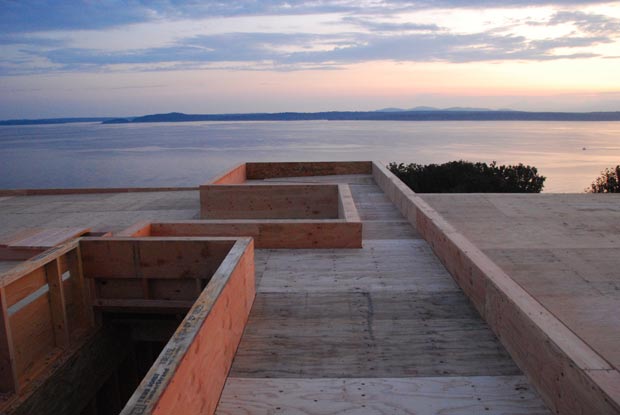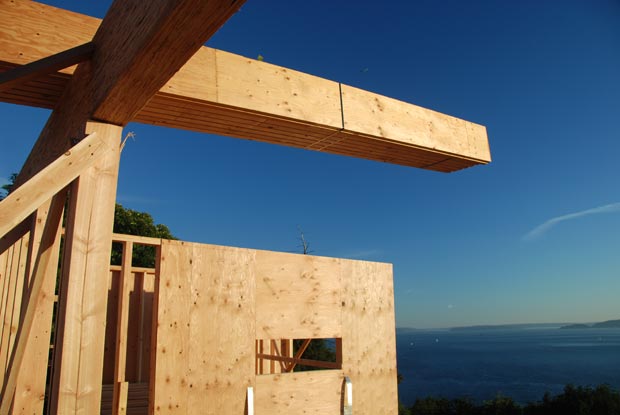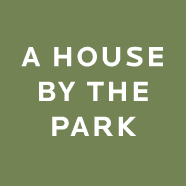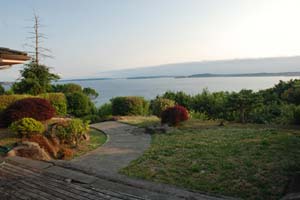Framing is moving at breakneck speed

Framing began on July 23rd (only 28 business days ago) and it is amazing how quickly it’s going. Scott and the three man crew at Alexander’s Custom Homes, Inc. have been doing a spectacular job in all aspects thus far. They are diligent, detail-oriented, efficient, courteous to neighbors, and reasonably priced.
From what everyone tells me, this is the most interesting phase of construction to watch. Each day, the house looks much different, and it’s a joy to drive to the site after work and see what’s new.
On the downside, some dry rot was discovered in some of the existing basement framing we were going to re-use, so the crew had to tear that out and replace it. Not a huge deal, but not expected either. On the bright side, it makes me all the happier we didn’t decide to just remodel the house. Between the dry rot, the pipes, and the wiring, it was in pretty bad shape.
As the house takes shape, almost every area is looking really great. However, we’ve identified some areas of concern as well. Some have been dealt with gracefully by the shifting of non load-bearing walls, but one big item remains.
Problem #1 was that both of the additional bedrooms looked extremely small once the walls went up. We successfully remedied this by chopping the linen area out of the additional bathroom upstairs and giving the extra room to the bedroom. You can now comfortably fit a queen sized bed in there. We are now left with one small additional bedroom and one large additional bedroom, which sounds perfect.
Problem #2 was that at only 80 square feet, the master bathroom was small, and, in our minds, well below average by modern standards for a house like this. By shifting a couple of walls and reducing the size of the walk-in closet a bit, this was increased to a more comfortable 96 square feet. It’s not a giant master bathroom by any stretch, but it’s big enough for a shower, two sinks, a toilet, and a large jetted tub. We’re not looking to throw dance parties in there or anything.
Problem #3 is more serious in scope and deals with the size of the master bedroom. We’ll be looking at ways to resolve this tomorrow and I’ll have a separate post on it shortly.
In the meantime, please feel free to check out the latest photo gallery of the framing stage.



What size are your bedrooms? We are at the tail end of our framing and I was also a bit concerned about the size of our bedrooms. The kids are 10×11. I think in the end it will be fine though.
Josh: The small bedroom is 8.5 feet by 11 feet and the enlarged one is 11.5 by 11. Both also have hallways and closets that are not included in those measurements, but those are the dimensions of the big rectangular areas. The master is 18 feet wide by 11 feet deep… it’s the depth that is a concern.
Mike,
I’m two years into a “all by myself” remodel of a joint on Mercer Island and we decided on a highly unconventional master bedroom that’s only 13′ wide by 11′ deep. (Our master closet is going to be almost the same size…).
We’re going to build the bed into the room with about 6″ of space along the sides and 24″ of space along the foot end and will enclose the space with sliding shoji screens (along the long side of the bed). A window with a view of Lake Washington is centered in the exterior wall at the foot end. So when the screens are closed it’s just you, the bed, and the lake. Running the long way of the room (parallel to the screens) we have a mini-hallway to connect the door to the bedroom to the screens, naturally, and also to a door to our deck.
I was browsing a book on Japanese architecture several years ago and fell in love with a picture of an engawa, that concept of an isolated space straddling the boundary of interior and exterior. It’s a bit ballsy (and not the most truthful interpretation of Japanese architecture by any stretch) but I think the completed design statement will stand up to resale value (however distant a concern resale is to us).
That is almost exactly our size (counting the closets). Our master is 11×22.
11′ does not feel too narrow at the moment and should provide 3-4 feet infront of a king size bed (depending on header and footer of course).
Mike,
Wow, what a view! It’s great watching the build. Will be fabulous to live there.
Chris
Who is “we” and how’s the exercise routing going during the build … still time to get a run in?
Framing on ours went incredibly fast — so does the drywall, there are other long lulls that left us frustrated. One week it’s massive progress and others not so much.
The top image is beautiful…makes me think you should change the name of the blog to ‘house with a view’.
Darin
Robin: That sounds really interesting! Can you send/post photos when you have them?
Josh: Yeah, 11 feet deep is not “uncomfortable” in my opinion, but it’s “noticeably shallow” so I didn’t really want to sign up for that.
Don: We is my girlfriend and I, and hell yes I’m still running! Building the house is actually causing me to run more, because I just drive up there every day after work, take a run around the neighborhood and then drive home.
Mike
Are you using SIP’s panels for framing? More eco-friendly, less labor, quicker framing, etc..? (Structurally Insluated Panels)
http://www.sips.org/
Lou: Nope, no SIPs. They look interesting, but we never really talked about them as an option. Even though I think you can use plywood with them, I’m pretty sure they are generally constructed using OSB, which is pretty bad to use in the Northwest where they will get rained on during construction and expand like sponges. Regardless, seems like an interesting technology… probably even more so for homes being built in bulk.
As for framing labor, the house went up pretty quickly (5 or 6 labor weeks with a three person crew) so I feel like we did a pretty good job there. Might SIPs have been a little quicker? Maybe, but probably not enough to matter.
Thx for the feedback on SIP’s… I know cost wise they are a bit more expensive but you make it up in labor and time (can frame up in a few days vs. weeks, etc…) House is shaping up nicely…
Lou: The time to manufacture the SIPs is greater though, so it’s not a one-to-one comparison. Also, we’ve had several in-progress changes we’ve made and they’ve been relatively easy so far because the framers can just make easy mods on site rather than have new components specially made. Would be interesting to see a total cost comparison somewhere to see how both methods stack up. I’m sure that with kit houses, SIPs make a ton of sense… the more you build off-site in a factory the better. With custom homes, it’s probably a lot closer to a toss up.
Lou,
Mike has a few good points about SIPs. They can be adjusted on site, but not easily. Also, if you’re doing a more custom project, SIPs may be slower rather than faster. We’re wrapping up a 2,000 s.f. SIPs project and the framing took about 2 months – twice as long as stick framing. Much of this was due to custom beams, posts and other miscellaneous structural components that took time to fabricate and install. If we were to replicate the project, this time would be reduced, but most custom projects are rarely replicated.
Having said that, SIPs and wood framing are two completely different systems. It’s nearly impossible to frame a stick built wall as energy efficient as SIPs even if you stagger the studs. It might be a little unfair to compare the two in terms of cost because of this. While our SIPs experience was slower than expected, we did a blower door test on the house before the windows and doors were foam sealed (before drywall) and saw an ACH of 2.79 – which is incredible. Code built homes are usually between 6 – 10 ACH and older homes are easily near 15 ACH.
Darin / Mike
Good to see a healthy debate here on SIP’s. We looked at both options for our custom residence in the Pacific Northwest and the vendor who does the SIP’s panels being local and the cost being
relatively similar between traditional and SIP’s we opted for SIP’s for the environmental impact, the
structural integrity, etc. You both bring up good points on either side of the argument…. No one option
is without its flaws but our contractor is so far promising quicker framing times than 2 months and ours
is a 3,000 sq. ft. project…
Lou: Sounds great. I can see a day where hopefully that technology is used in all projects. For the record, the bulk of my stick framing was done in 4 weeks (by three guys), and it’s something like 3700 square feet including garage. Weeks 5 and 6 have been spent on change orders and other details that wouldn’t be part of an initial bid package.
The bedrooms looked indeed very small. I had wondered how kids would get their beds and desks in there, in case you get kids.
Good to know. Thx!
I missed this post. But wow! This is the first post where I got a “feel” of the view. The location looks amazing and the layout seems to fit the location.